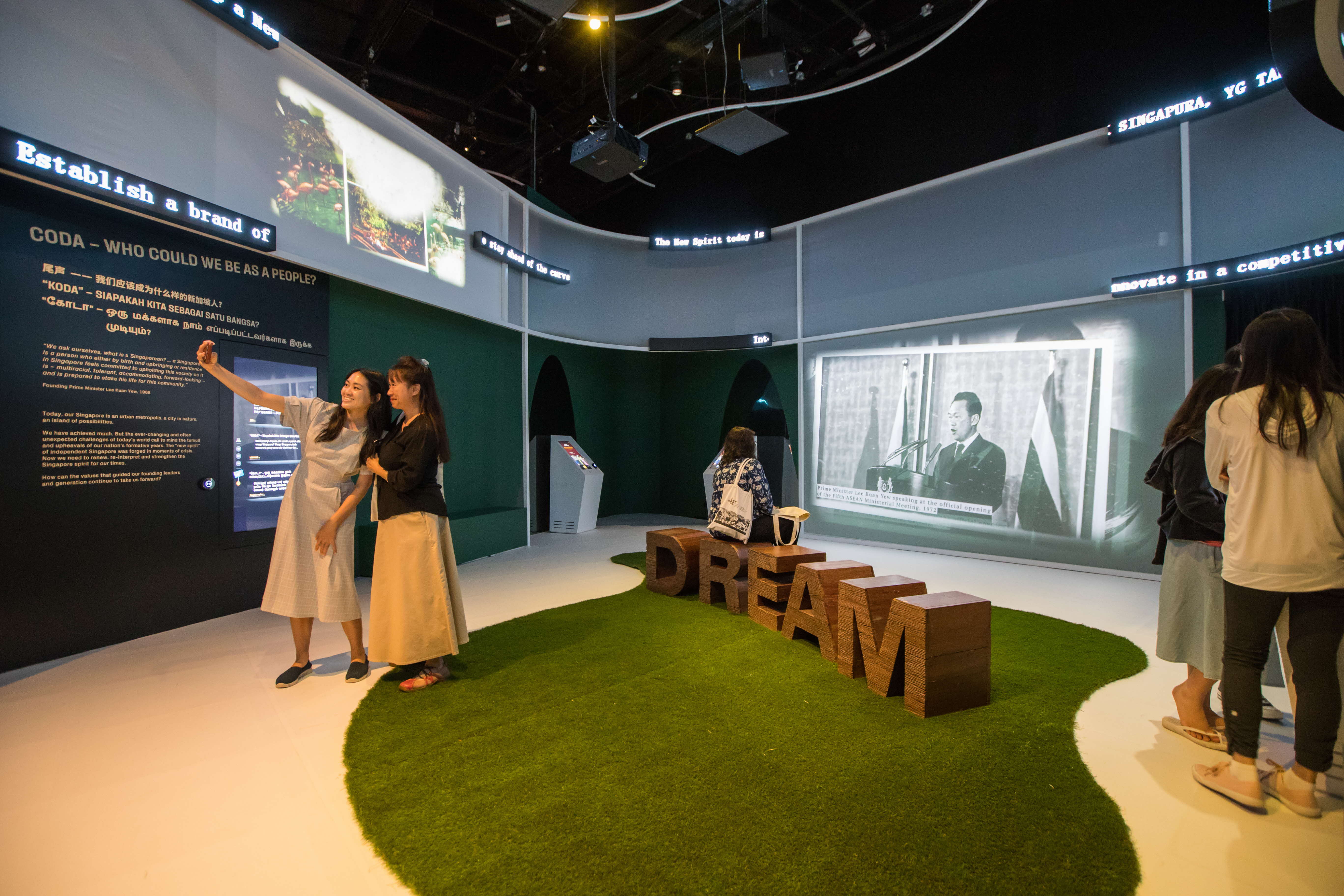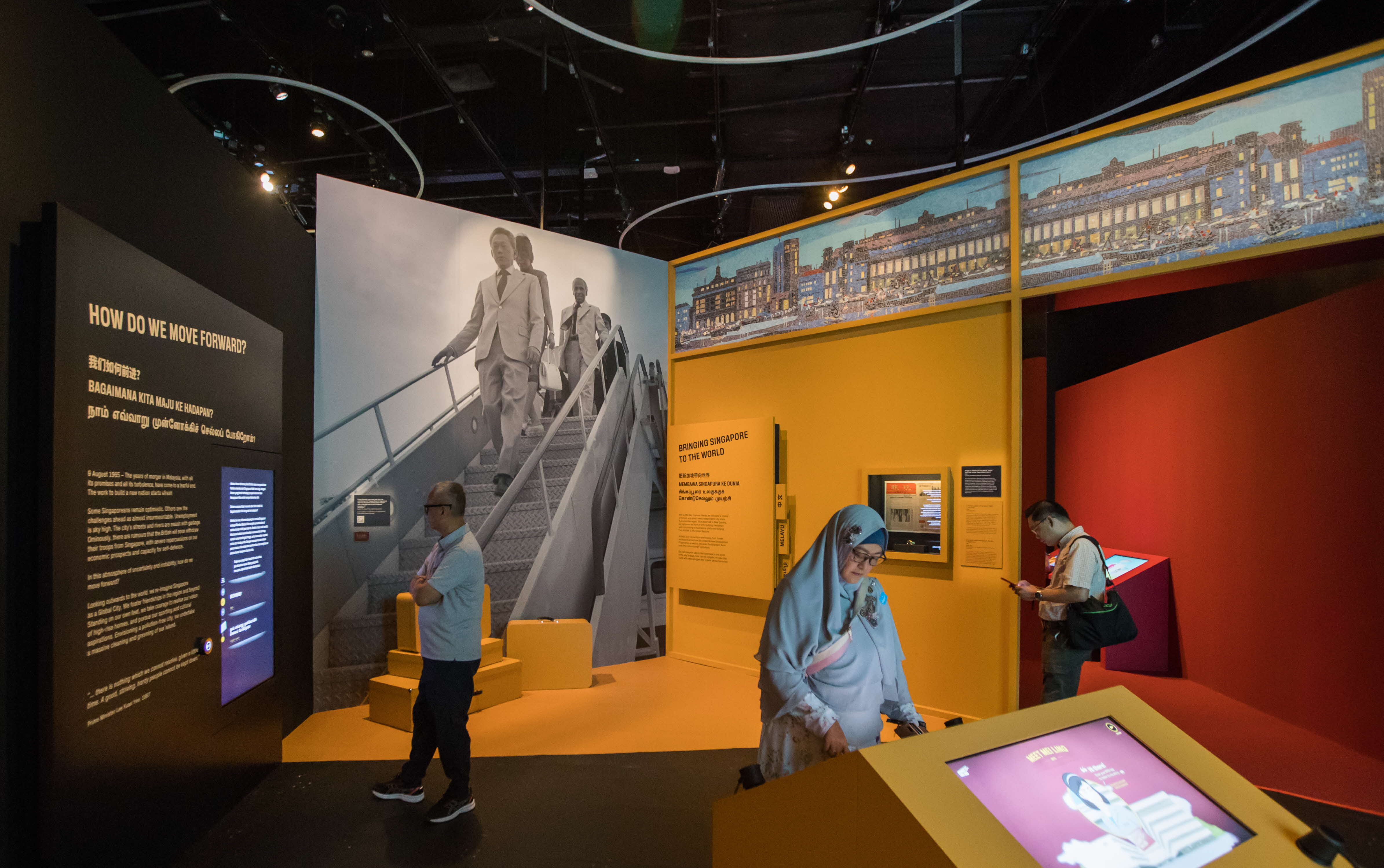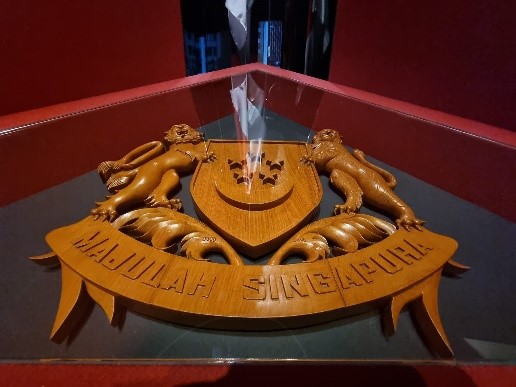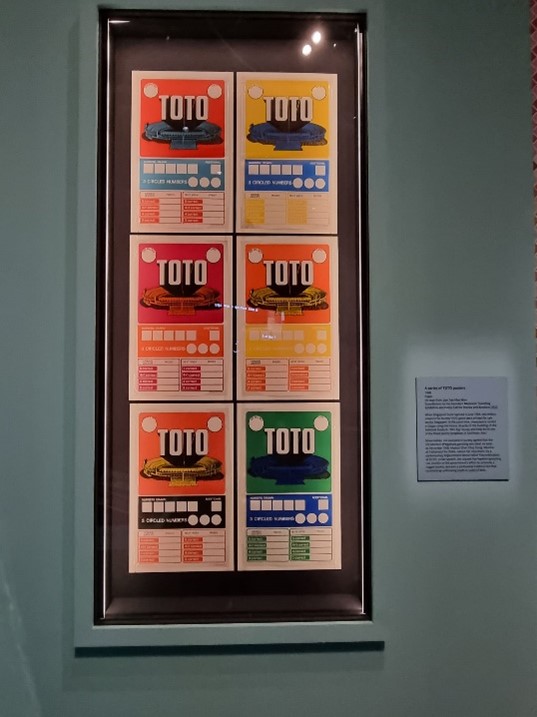CLICK THE IMAGE BELOW TO EXPLORE SEMANGAT YANG BARU: FORGING A NEW SINGAPORE SPIRIT VIA A VIRTUAL TOUR
MEDIA RELEASE
THE FOUNDERS’ MEMORIAL LAUNCHES PILOT EXHIBITION ON SINGAPORE’S FOUNDING LEADERS AND VALUES
‘Semangat yang Baru: Forging a New Singapore Spirit’ explores the dynamism and courage that drove the leaders and people of Singapore as they forged a new nation. It invites Singaporeans to think about what the new spirit means to them in the context of Singapore’s future. This pilot exhibition is part of the Memorial’s ongoing public engagement.
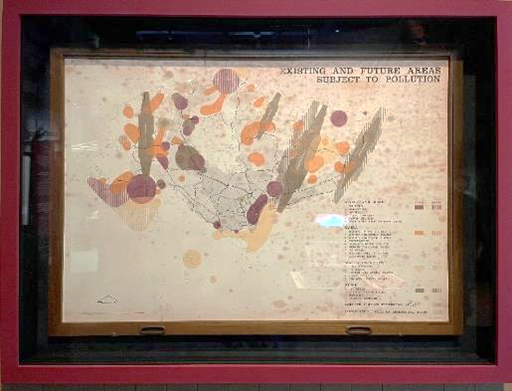
Map titled Existing and Future Areas Subject to Pollution (Mid-1970s)
Gift of Prime Minister’s Office. Collection of National Museum Singapore.
A new acquisition by the Memorial, this map once hung in founding Prime Minister Lee Kuan Yew’s Istana office, and clearly shows existing and future areas subject to pollution. It illustrates Mr Lee’s far-sighted concern for the environment and well-being of the people even amidst more pressing issues of nation-building.
Singapore, 20 April 2023– The Founders’ Memorial’s pilot exhibition,Semangat yang Baru: Forging a New Singapore Spirit, features stories about the dilemmas and decisions faced by our founding leaders and generation during Singapore’s nation-building years of the 1950s to 1970s.“Semangat yang Baru” are words from the National Anthem, meaning ‘new spirit’. The exhibition explores how values and principles such as multiculturalism, integrity and openness became the foundation upon which independent Singapore was built, and invites Singaporeans to reflect on how these ideals remain relevant today.
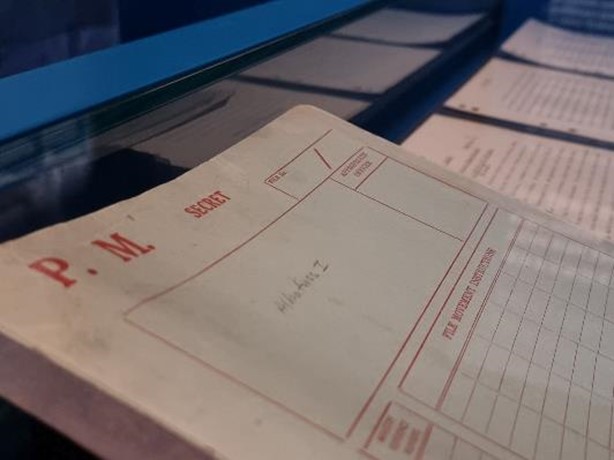
Notes of meeting with Malaysia’s Deputy Prime Minister Tun Razak, taken by Singapore’s Deputy Prime Minister Toh Chin Chye (10 February 1965)
Prime Minister’s Office Collection, courtesy of National Archives of Singapore
Specially declassified for display in the exhibition, this document penned by Toh Chin Chye explains how Singapore’s and Malaysia’s different approaches to multiracialism made it difficult for Singapore to remain in the Federation in its existing structure, and explores options for a looser constitutional arrangement. This document is part of a file codenamed “Albatross” by then-Minister for Finance Goh Keng Swee. The name possibly alludes to his feelings that merger was an albatross around one’s neck – a burden to Singapore.
2 The exhibition is a pilot for the Memorial to test how it would present its narrative for its eventual interpretive gallery. In curating this exhibition, the Memorial conducted in-depth discussions with close to 200 participants, including academics, educators,community leaders, youth and seniors, on what stories could be featured and how these could be presented in a way that is authentic and resonant. This phase of public engagement follows the Memorial’s public call for artefacts and stories, which was launched in April 2022. Selected artefacts and stories will be featured in the Memorial’s gallery when it opens, and some have been identified to be displayed as part of the pilot exhibition.
3 One such artefact is adachingpig weighing scale contributed by Mr Tan Kah Hoe and Mdm Amy Phua. Mr Tan was formerly a pig farmer.Pig farming was a major agricultural activity and source of livelihood in Singapore until 1984. The rearing of pigs and other livestock was eventually phased outto ensure Singapore’s water catchments remain free of waste discharged from farms upstream.This decision reflected competing environmental and economic priorities confronting policymakers, and entailed sacrifices by the farmers who had to be resettled.
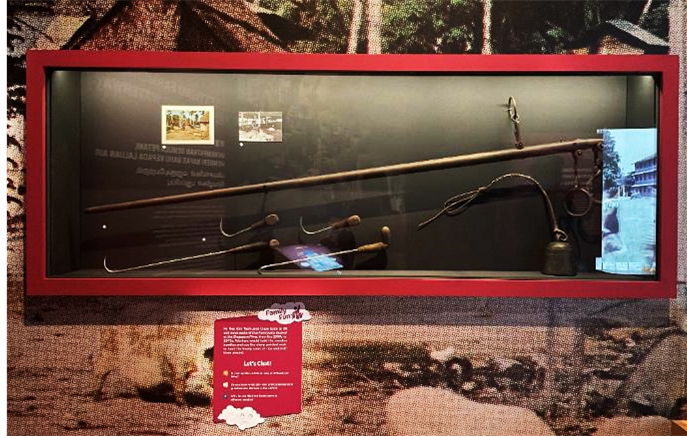
Daching pig weighing scale (1930s)
Gift of Tan Kah Hoe and Amy Phua.
Contribution to the Founders’ Memorial Travelling Exhibition and Public Call for Stories and Artefacts 2022.
The pig scale (top of photo) was used by the Tan family to weigh live pigs on their farm in Kampong San Teng between the 1930s and 1970s. Pigs of up to 200 kati (1 kati = 600g) would be weighed in baskets before being sent to Kim Chuan Road Abattoir for slaughter. At its peak, the farm reared between 500 to 600 pigs. The Tan family eventually moved to a 3-room Housing and Development Board (HDB) flat in Ang Mo Kio in 1978.
4 Through the innovative use of technologies such as cloud infrastructure and 5G connectivity, the multimedia featured in the exhibition promises an authentic and personalised storytelling experience. Virtual guides known as “Character Companions”, derived from real-life figures and stories, provide personal perspectives on larger historical developments, and help visitors to understand the trade-offs and impact of policy decisions on individuals and communities. Visitors may also respond to questions posed at multimedia kiosks situated throughout the exhibition and discover which of the founding values they identify most with. More information on the exhibition and artefact highlights can be found inAnnex A.
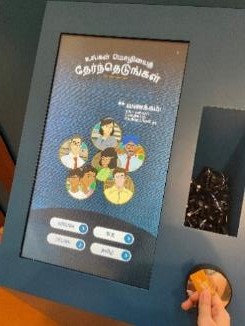
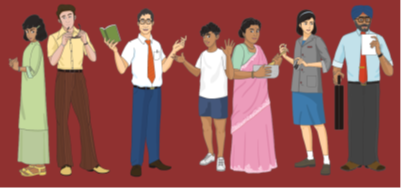
Characters include an educator who had to switch from teaching in Mandarin to English, a mother-son pair who just resettled from an attap house into an HDB flat, and a lady who is inspired by women’s groups to champion for monogamy and awareness of family planning.
5 The exhibition is co-presented with the National Museum of Singapore and will be located at the museum’s Exhibition Gallery 1 from 21 April to 29 October 2023. Admission is free for all Singaporeans and Permanent Residents. Programmes to complement the exhibition include bus tours to the exhibition, where participants engage in an interactive experience with role-playing tour guides; and engagement sessions reaching out to different demographics through films, lectures, and group activities. For more details on the programmes, please refer to Annex B.
6 Mr Lee Tzu Yang, Co-Chairman of the Founders’ Memorial Committee, said: ““The Founders’ Memorial is to be a space owned by each generation of Singaporeans. This is why we have been engaging Singaporeans since the very beginning of conceptualisation. This pilot exhibition is an important milestone in this engagement. It has been shaped and enriched through artefacts and stories contributed through our public call, as well as ideas and themes raised during discussions. We invite further feedback from Singaporeans on the exhibition to help us to refine the narrative and engagement modalities used in the exhibition. We want you to continue building the stories in the Memorial with us, now and into the future.”
7 Ms Wong Hong Suen, Director, Founders’ Memorial, said: “In building a new nation, our founding leaders were confronted with pressing questions such as: What do we stand for? How do we survive? They did not have a blueprint for nation-building and there was much uncertainty. Yet, how they forged ahead to build our fledgling nation together with the people, and the values and priorities they stood for, became foundational to what Singapore is today. We hope that the exhibition, and the eventual Founders’ Memorial, will encourage visitors to reflect on what our founding values mean for us today, and find inspiration for the way forward.”
Commemoration of the 100th anniversary of Mr Lee Kuan Yew’s birth
8 As Singapore’s founding Prime Minister, Mr Lee Kuan Yew holds a special place in Singapore’s history and the exhibition.This year marks the 100th anniversary of Mr Lee’s birth. To commemorate his life and contributions to Singapore,the National Museum of Singapore and the Founders’ Memorial will be launching a digital trail spanning the Semangat yang Baru: Forging a New Singapore Spiritexhibition and the post-war Singapore section of the Singapore History Gallery. Visitors are invited to embark on a trail in the exhibition to find out more about Mr Lee’s legacy and the values he embodied. They can continue the trail in the Singapore History Gallery, to find out more about Mr Lee’s life and career, and how his ideas and actions shaped the path of our nation.
9 There are other activities being planned in the National Heritage Board’s museums to commemorate this anniversary. The National Museum is commissioning Singaporean filmmaker Royston Tan to produce a short film based on Mr Lee’s historic speeches. More details on the film’s launch will be announced later. Separately, Children’s Museum Singapore is planning a pop-up exhibition in August to introduce children to Singapore’s founding Prime Minister, giving them a window into his childhood, student days and his contributions to the nation.
10 Please refer to the following annexes for more information:
● Annex A:Exhibition and artefacthighlights ofSemangat yang Baru: Forging a New Singapore Spirit
● Annex B:List of programmes
● Annex C:Factsheet on Founders’ Memorial
● Webpage:www.go.gov.sg/semangatyangbaru
- END –
For media enquiries, please contact:
|
Say Hua Lee Mobile: 9668 4605 Email: sayhua.lee@tateanzur.com |
Cherell Soon Mobile: 8102 9131 Email: cherell.soon@tateanzur.com |
About the Founders’ Memorial
The Founders’ Memorial will commemorate the founding values and ideals exemplified by Singapore’s first generation of leaders, as well as other key figures who played important roles in Singapore’s path to independence and nation-building journey. The Memorial will focus on the period of 1950s to 1970s in Singapore’s history, explored through the lens of policy deliberations, dilemmas and decisions that illustrate how our leaders and people were guided through the tumultuous nation-building years by founding values such as multiculturalism, resilience and openness. Distilled from the Memorial’s continued engagement with Singaporeans since its inception in 2015, these values have become foundational to Singapore, and continue to underpin who we are today as a people and nation.
Envisioned as an integrated gallery and gardens experience at the Bay East Garden, the Memorial will not only commemorate the past, but inspire Singaporeans to commit themselves towards a better future. It will be a space that captures the spirit of our nation, serving as a unifying point for all Singaporeans. More information on the Founders’ Memorial is available at foundersmemorial.sg.
|
TRANSLATION OF TERMS |
|
Founders’ Memorial 建国先贤纪念园 Taman Tugu Pengasas சிங்கப்பூர்ச் சிற்பிகள் நினைவகம் |
|
Semangat yang Baru: Forging a New Singapore Spirit Semangat yang Baru -- 共创狮城新精神 Semangat yang Baru: Menjalin Semangat Singapura yang Baru புத்துணர்வு: ஒரு புதிய சிங்கப்பூர் உணர்வை உருவாக்குவோம்
|
ANNEX A
EXHIBITION AND ARTEFACT HIGHLIGHTS
There are five sections in the Semangat yang Baru: Forging a New Singapore Spirit exhibition:
● Prelude - The 1950s, which introduces visitors to the tumult, uncertainty and ferment that characterised the post-war era
● What do we stand for?, which delves into the values that were critical to the founding stage of our nation and consists of a sub-section called Interlude - We Pledge Ourselves on the design of our National Symbols
● How do we move forward?, which revisits how the founding generation of leaders and people collectively embodied and expressed the new spirit as a nation by stepping forward in new and bold ways
● Difficult Moments, a wall installation where visitors are invited to pen their thoughts on the painful sacrifices, hurts or difficult trade-offs that come to their mind when reflecting on Singapore’s early nation-building years
● Coda, Who could we be as a People? a concluding section where visitors are surrounded by a projection of photos showing the Singapore spirit in action then and now, together with a live visual and audio projection of responses gathered from visitors.
Artefact highlights
|
Artefact |
Description |
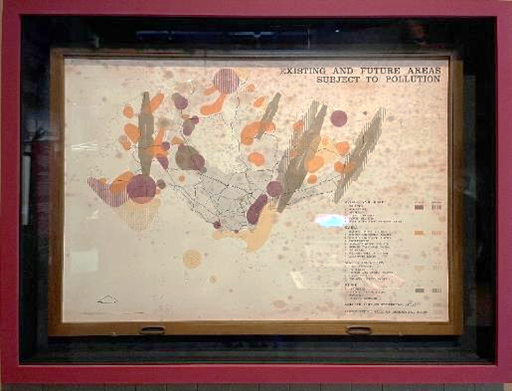 |
Map titled Existing and Future Areas Subject to Pollution Mid-1970s Paper, wood Gift of Prime Minister’s Office 2022-00595
This map, produced by the Planning Department, hung in founding Prime Minister Lee Kuan Yew’s office. It clearly shows existing and future areas subject to smoke, smell, water, noise and dust pollution, which speaks to Mr Lee’s foresight and long-term vision for a clean and green Singapore. For example, noise from the then Singapore International Airport at Paya Lebar is clearly marked out, as is vehicle exhaust from cars in the Central Business District.
|
|
|
Notes of meeting with Malaysia’s Deputy Prime Minister Tun Razak, taken by Singapore’s Deputy Prime Minister Toh Chin Chye 10 February 1965 Paper Prime Minister’s Office Collection, courtesy of National Archives of Singapore
Specially declassified for display in this exhibition, this document penned by Toh Chin Chye (1921–2012) explains how Singapore’s and Malaysia’s different approaches to multiracialism made it difficult for Singapore to remain in the Federation in its existing structure, and explores options for a looser constitutional arrangement. This document is part of a file codenamed “Albatross” by Singapore’s Minister for Finance Goh Keng Swee (1918–2010). The name possibly alludes to his feelings that merger was an albatross around one’s neck – a burden to Singapore.
By December 1964, amid repeated heated exchanges between the Singapore government and Federal government over issues of race and the economy, secret negotiations for a looser federation began at the highest levels of both Cabinets. These discussions stalled over disagreements on the degree of autonomy for Singapore and extent of its involvement in Federal Parliament and politics.
Meanwhile, fundamental clashes between Singapore and Kuala Lumpur worsened. By June 1965, Prime Minister of Malaysia Tunku Abdul Rahman decided that Singapore must part ways with the Federation, and separately, Goh Keng Swee had the same idea. Negotiations were quickly conducted in absolute secrecy – Goh led the discussions, while Minister for Law E. W. Barker (1920–2001) drafted the necessary legal documents.
On 9 August 1965, Singapore’s separation from Malaysia was announced.
|
|
|
National coat of arms made by the Baharuddin Vocational Institute Wood, metal 1965–1990 Gift of the Parliament of Singapore 2020-00200
Singapore’s national coat of arms was adopted on 3 December 1959, six months after Singapore gained full internal self-government, in replacement of colonial representations of power. The symbol embodies Singapore’s values and ideals, and was introduced to unite the ethnically diverse population of the new state.
Previously displayed in the Old Parliament House, this national coat of arms was a gift from the Baharuddin Vocational Institute (1965–1990). The institute was Singapore’s first tertiary school dedicated to manual and applied arts, established to train skilled workers to support the nation’s rapid industrialisation programme.
|
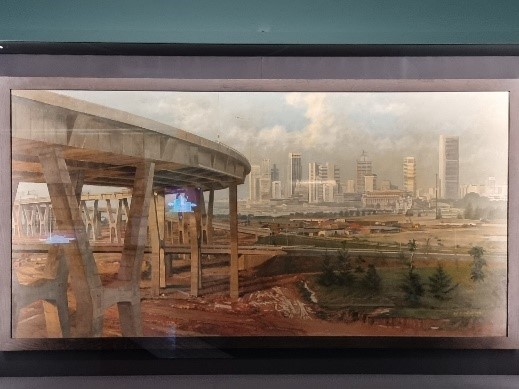 |
Benjamin Sheares Bridge – The Viaduct 1981 Chua Mia Tee Oil on canvas On loan from National Gallery Singapore P-1109
This oil painting by one of Singapore’s most well-known social realist painters depicts the Benjamin Sheares Bridge in its final construction stage, with the Central Business District in the background. Built on reclaimed land, the bridge’s trestles were designed to facilitate the passage of ships from shipyards in the Kallang Basin. However, these shipyards were relocated when actual construction works began.
|
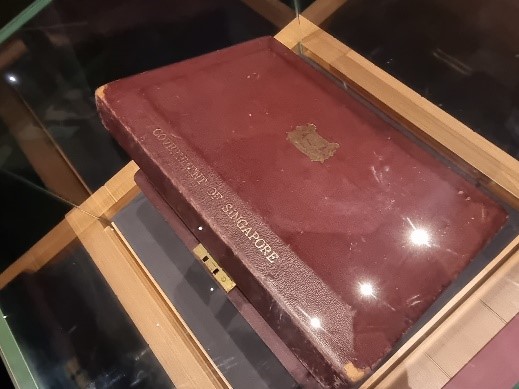 |
Red Box No. 1 used by founding Prime Minister Lee Kuan Yew 1950s Wood, ram’s leather, metal Gift of Prime Minister’s Office 2021-00479
A legacy of Singapore’s British colonial heritage, this red despatch box contained Mr Lee’s day-to-day documents as he shuttled between his residence and his office. It typically held to-do files, draft letters, as well as cassette tapes containing dictated instructions for follow-up.
Mr Lee continued to maintain a watchful eye over the state of Singapore’s cleanliness well into his later years. On one occasion in 2010, Mr Lee gave instructions for pictures to be taken after he noticed pieces of garbage floating on the Singapore River. These instructions, given while Mr Lee was grieving the passing of his late wife Madam Kwa Geok Choo, would likely have been ferried in a red box to his office the next day for further action.
|
|
|
Daching pig weighing scale c1930s Wood, metal, lead Gift of Tan Kah Hoe and Amy Phua 2022-00597-001 to 002 Contribution to the Founders’ Memorial Travelling Exhibition and Public Call for Stories and Artefacts 2022
This daching weighing scale was used by the Tan family to weigh live pigs on their farm in Kampong San Teng between the 1930s and 1970s. Pigs of up to 200 kati (1 kati = 600g) would be weighed in baskets before being sent to Kim Chuan Road Abattoir for slaughter. At its peak, the farm reared between 500 to 600 pigs, as well as a few hundred chickens and ducks. The Tan family eventually moved to a 3-room Housing and Development Board (HDB) flat in Ang Mo Kio in 1978. |
|
|
A series of TOTO posters 1968 Paper On loan from Dan Teo Khai Mun Contribution to the Founders’ Memorial Travelling Exhibition and Public Call for Stories and Artefacts 2022
When Singapore Pools opened in June 1968, two million coupons for its new TOTO game were printed for sale across Singapore. At the same time, newspapers carried a slogan tying the lottery directly to the building of the National Stadium: “Win big money and help build one of the finest sports complexes in Southeast Asia.”
Nevertheless, not everyone in society agreed that the introduction of legalised gambling was ideal. As early as December 1968, Madam Chan Choy Siong, Member of Parliament for Delta, raised her objections via a parliamentary Adjournment Motion titled “Discontinuation of TOTO”. In her speech, she argued that legalised gambling ran counter to the government’s effort to promote a rugged society, and was a particularly insidious vice that could entrap unknowing youth in cycles of debt. |
ANNEX B
LIST OF PROGRAMMES
|
LKY100 Trail
This year marks the 100th anniversary of Mr Lee Kuan Yew’s birth. To commemorate our Founding Prime Minister’s life and contributions to Singapore, the National Museum of Singapore and the Founders’ Memorial will be launching a digital trail spanning theSemangat yangBaru: Forging a New Singapore Spirit exhibitionand the post-war Singapore section of theSingapore History Gallery.Visitors are invited to embark on a digital trail to find out more about Mr Lee’s legacy, the values he embodied in his life and career, and how his ideas and actions shaped the path of our nation.
|
|
Interactive Bus Tours to Semangat yang Baru: Forging a New Singapore Spirit Exhibition
Take a ride back in time to Singapore’s independence years of the 1950s to 1970s, when the leaders and people of Singapore rallied together to build our fledgling nation. Your journey to the exhibition starts the moment you board the bus and continues in the National Museum of Singapore, with your friendly character guide, who will share stories about real challenges and dilemmas during this exciting period of our history. Return transport is provided. Each participant will also receive a limited-edition Founders’ Memorial tote bag filled with snacks! There are two daily timings available: · 10:00am – 1:00pm · 1:30pm – 3.30pm
|
|
Film Programme
In partnership with Honour Singapore, a specially curated series of short films highlighting the values exemplified by the founding generation will be paired with a panel discussion involving thought leaders.
Join us for an evening of thought-provoking conversations about the dilemmas that our founding generation faced as we boldly strove to build a society based on justice and equality.
|
|
Conversations at Semangat yang Baru
Come together with friends old and new to explore the exhibition, participate in group activities, and share your thoughts on what “Semangat yang Baru” means to you.
This is a special programme that is part of the engagement journey of the Founders’ Memorial and seeks to understand different perspectives and responses to the exhibition across visitor groups. |
|
HistoriaSG
HistoriaSG is a lecture series that focuses on important but lesser-known aspects of Singapore’s history.
Look forward to lectures held in conjunction with Semangat yang Baru, which will shed new light on Singapore’s challenges and dilemmas between the 1950s to 1970s.
Curator Tours Join us for a behind-the-scenes look at Semangat yang Baru. Explore the exhibition with our curators as they share more about how they conceptualised the exhibition narrative and provide insights on their selection of stories and artefacts.
|
ANNEX C
FACTSHEET ABOUT THE FOUNDERS’ MEMORIAL
About the Founders’ Memorial
The Founders’ Memorial will commemorate the founding values and ideals exemplified by Singapore’s first generation of leaders, as well as other key figures who played important roles in Singapore’s path to independence and nation-building journey. The Memorial will focus on the period of 1950s to 1970s in Singapore’s history, explored through the lens of policy deliberations, dilemmas and decisions that illustrate how our leaders and people were guided through the tumultuous nation-building years by founding values such as multiculturalism, resilience and openness. Distilled from the Memorial’s continued engagement with Singaporeans since its inception in 2015, these values have become foundational to Singapore, and continue to underpin who we are today as a people and nation.
Envisioned as an integrated gallery and gardens experience at the Bay East Garden, the Memorial will not only commemorate the past, but inspire Singaporeans to commit themselves towards a better future. It will be a space that captures the spirit of our nation, serving as a unifying point for all Singaporeans.
Honouring our founding leaders
The Founders’ Memorial will focus on key leaders integral to the first two decades of Singapore’s nation-building years such as Lee Kuan Yew, S Rajaratnam, Goh Keng Swee, Othman Wok and E.W. Barker, among others in Singapore’s first to fourth Cabinets. In fleshing out the national milestones and key policies in our nation-building history, we will also look at individuals who played key leadership roles in post-independent Singapore. These include but are not limited to:
- Community leaders;
- Heads of State, political office holders, Members of Parliament, civil servants, heads of statutory boards and government-linked companies;
- Members of political parties who played key roles in the years leading up to independence
Commemorating the founding values upon which Singapore is built
The narrative of the Founders’ Memorial will be anchored by founding values exemplified by Singapore’s first generation of leaders and people. They include: multiculturalism, boldness, resilience, openness, service to others before self, and integrity. These founding values were derived from public engagements conducted since the inception of the Memorial in 2015, and will be refined further as the Memorial continues to engage Singaporeans leading up to its opening.
- Multiculturalism: Appreciating our distinct cultural characteristics while embracing a Singaporean identity and shared purpose.
- Boldness: Having the courage to dream big and daring to be different.
- Resilience: Showing perseverance and picking oneself back up even after setbacks.
- Openness: Staying outward-looking and connected to the world, and welcoming opportunities that this brings.
- Service to Others before Self: Having a sense of public duty and purpose and working together towards a common cause.
- Integrity: Having the moral courage and accountability to do the right thing even when it is hard.
An example of how integral these founding values are to our nation-building story is the development of the Jurong Industrial Estate in the 1960s. Dr Goh Keng Swee's (then Minister for Finance) plan to industralise Jurong was nicknamed "Goh's Folly". Then, Singapore had no experience in manufacturing, the labour market was unstable, and high infrastructural costs were needed to turn a swamp into an industrial estate. However, through the boldness of our founding leaders and people, Jurong Industrial Estate became home to 181 factories with over 20,000 workers by 1969. This value of boldness continues to define Singapore’s aspirations, through ideas and projects such Jewel Changi Airport, which transformed the idea of what an airport could be.
Involving Singaporeans in the making of the Memorial
Since the inception of the Founders’ Memorial in 2015, Singaporeans have been engaged at various stages and on various aspects of the Memorial’s development, including its objectives, concept, location, design, visitor experience, and most recently, narrative and content.
For the public engagement on content, a public call for artefacts and stories was launched in April 2023. Selected artefacts and stories will be featured in the galleries of the Founders’ Memorial when it opens, but some will be displayed as part of the “Semangat yang Baru: Forging a New Singapore Spirit” special exhibition.
The exhibition serves as a pilot for the Memorial’s interpretive gallery when it opens in 2027, as well as its visitor experience and engagement strategies. In curating the exhibition, the Memorial engaged different groups of stakeholders and Singaporeans on how to present the exhibition’s narrative in a way that is authentic and resonant. Visitors to the exhibition will also be invited to participate in exhibition-anchored engagements to provide feedback which will serve to further refine the Memorial’s narrative ahead of its launch.





